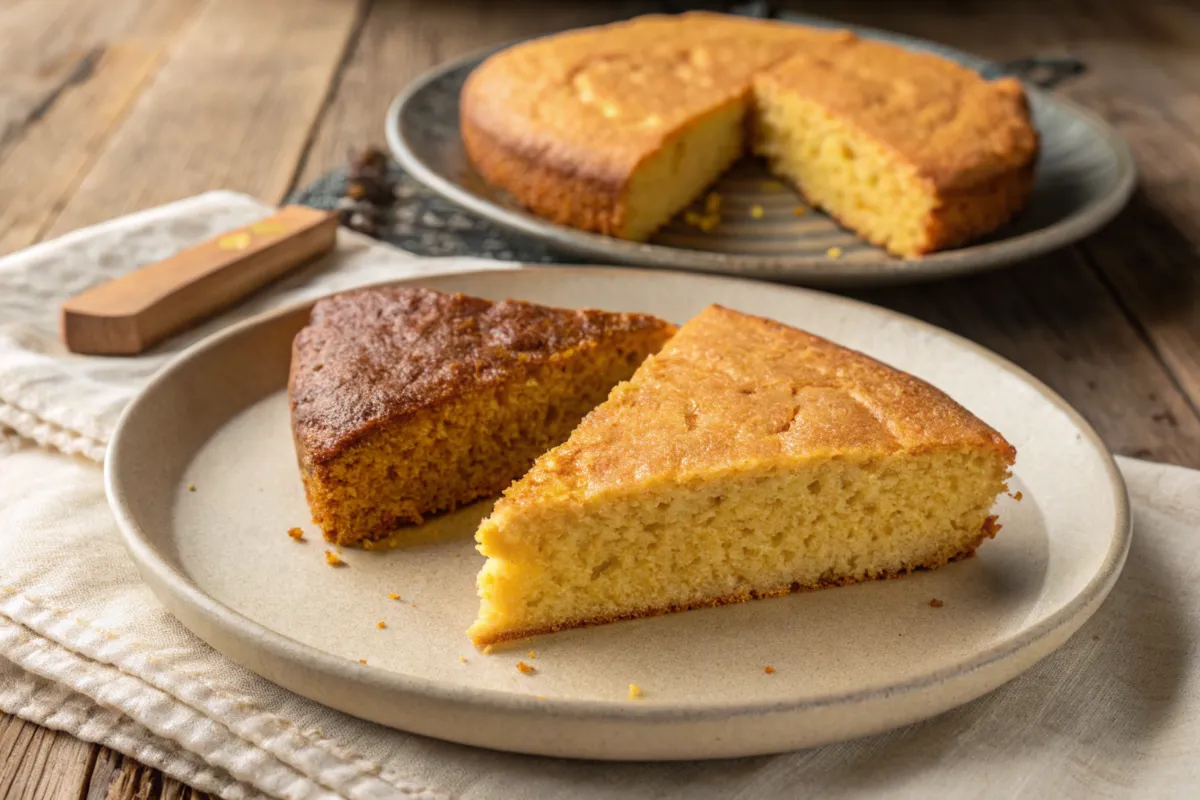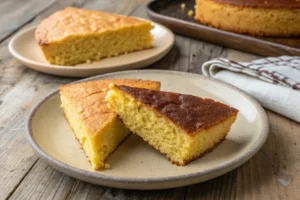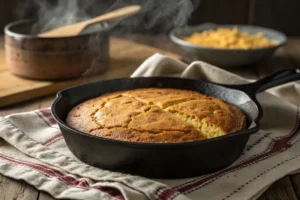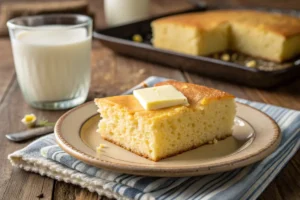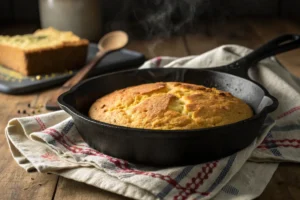introduction
What is the difference between cornbread and southern cornbread?: This article explores the key differences between cornbread and southern cornbread, from their ingredients to their flavors and textures. We’ll cover everything you need to know to bake the perfect cornbread for your needs.
Understanding the Basics of Cornbread
Cornbread is a quick bread made primarily from cornmeal. Its origins trace back to Native American cuisine, where corn was a staple. Therefore, it’s a dish with deep roots in American history. Consequently, cornbread has many forms and variations. However, generally, all types share a common base of cornmeal, flour, and a liquid. Understanding these basic components is essential to grasping the difference between cornbread and southern cornbread.
Common Cornbread Traits
Firstly, consider that most cornbreads include cornmeal. Secondly, they usually require a leavening agent, like baking powder or baking soda. Additionally, most recipes involve some form of liquid, which is often milk or buttermilk. Furthermore, many cornbread recipes also include an oil or melted butter for moisture. These common traits create the foundation for all kinds of cornbread. Finally, depending on the recipe, you could add eggs for a richer texture.
What Defines Southern Cornbread?
Southern cornbread, however, stands apart from other cornbread varieties. It is known for its simplicity and savory flavor. Accordingly, it often lacks added sugar. Additionally, it traditionally uses stone-ground cornmeal, which gives it a coarser texture. Moreover, Southern cornbread also features buttermilk or another acidic liquid. Therefore, it is a unique take on a classic bread.
Key Aspects of Southern Cornbread
First, and foremost, the most noticeable thing about southern cornbread is its lack of sweetness. Furthermore, it has a crumbly texture and a slightly nutty flavor. Moreover, many traditional recipes don’t include flour; they rely solely on cornmeal. These are key elements that define its unique nature. Additionally, some recipes use lard or bacon drippings for extra richness.
The Role of Buttermilk
Specifically, buttermilk plays a vital role in southern cornbread. In fact, it adds tanginess. Also, it helps the bread to be tender and moist. Therefore, buttermilk creates a characteristic flavor that sets it apart from other kinds. Conversely, milk or water may be used in other cornbread recipes.
The Difference Between Cornbread and Southern Cornbread
So, what is the difference between cornbread and southern cornbread? The difference mainly lies in the sweetness level. While many cornbreads are sweet, southern cornbread is savory. Moreover, the texture and ingredients can also vary greatly. Consequently, these differences are quite important for those looking to bake a specific style. Therefore, understanding them is key to making a proper selection of recipe.
Sweetness Levels: A Major Divide
Indeed, the sweetness level is the most significant difference. Firstly, traditional cornbread often includes sugar or honey. In contrast, Southern cornbread avoids these additions. Hence, this creates two very distinct flavor profiles. Therefore, choosing between them depends heavily on your personal taste.
Texture and Consistency: Another Distinction
Secondly, the texture and consistency are notably different. Southern cornbread tends to be more crumbly. It has a coarser grain and is not as fluffy as other cornbreads. On the other hand, standard cornbread can be more cake-like. Moreover, sometimes it can be quite moist and soft.
Ingredient Variations: Furthering the Gap
Thirdly, the choice of ingredients also sets them apart. For instance, Southern cornbread often only uses cornmeal, while other types can include more flour. Additionally, the liquid component can differ. Furthermore, standard cornbread is more likely to include eggs or butter. Conversely, southern versions may keep it simpler, only using buttermilk.
The Ingredients: A Closer Look
Therefore, let’s look closer at the ingredients of each. The quality and type of ingredients greatly affect the final outcome. Accordingly, understanding these differences will help you make the best choice for your recipe. In addition, it can help you understand what is the difference between cornbread and southern cornbread.
Cornmeal: The Foundation
Cornmeal is the central component of all cornbreads. However, the type of cornmeal can vary. Consequently, southern recipes often specify using stone-ground cornmeal. On the other hand, you can use fine or medium-ground cornmeal in other types. Furthermore, the difference in the cornmeal grain affects the final texture.
Liquid Choices: Milk vs. Buttermilk
The choice of liquid is a key element in the cornbread’s flavor. Buttermilk is favored in southern cornbread, while other cornbread recipes might use milk or even water. Accordingly, buttermilk adds a unique tanginess. Conversely, milk might result in a milder, less acidic flavor.
Sweeteners: Sugar or No Sugar?
The addition of sweeteners is a crucial factor. Indeed, southern cornbread typically excludes sugar. Conversely, recipes for other types often include sugar or honey. Therefore, this single ingredient impacts the flavor significantly. In other words, if you add sugar, you get a sweeter product.
Leavening Agents: Baking Powder and Baking Soda
Additionally, both baking powder and baking soda are common leavening agents. They help the bread rise and achieve the right texture. However, the amount used can vary slightly between recipes. Therefore, pay attention to the proportions mentioned in each recipe.
Fat: Oil, Butter or Lard
Moreover, fat is another important element. Common choices include melted butter or oil. However, some traditional southern recipes use lard or bacon drippings. Thus, these fat sources create a distinct flavor and texture. In effect, it affects how the final product tastes.
Flavor Profiles: Savory vs. Sweet
The flavor profiles are what truly distinguish the two. Southern cornbread is distinctly savory, while other types are typically sweeter. Accordingly, this difference stems from the ingredients used in each recipe. In conclusion, this makes each type suitable for different meals.
Southern Cornbread: A Savory Delight
Specifically, southern cornbread is known for its mild, slightly nutty flavor. Moreover, it is not very sweet and its flavor is often enhanced by the richness of lard or bacon drippings. Therefore, it pairs well with savory foods. For instance, it goes great with stews, chilis, or barbeque.
Sweet Cornbread: A Cake-Like Treat
Conversely, sweet cornbread, often referred to as northern cornbread, is more like a cake. It has a sweeter flavor and a softer texture. Consequently, it is more suitable for dessert or as a side dish to dishes with sweetness. Thus, it is a matter of personal preference.
Serving Suggestions: Pairing with Meals
Accordingly, consider how each type of cornbread pairs with different dishes. Southern cornbread is a perfect match for heartier, savory meals. Conversely, sweeter versions are better suited for dishes that can handle the extra sugar. Hence, these are things to consider when cooking.
Baking Techniques: Similarities and Differences
The baking techniques are fairly similar but with subtle differences. However, the method can also impact the texture and overall taste. Therefore, these details are crucial when cooking both types. Specifically, let’s look at how they differ in practice.
Mixing Methods: How to Combine Ingredients
Firstly, the mixing method is important. Both require combining the dry ingredients before mixing in the wet ingredients. However, some recipes might have specific instructions for combining the wet ingredients. Consequently, following the recipe instructions is always important.
Baking Temperatures: Ensuring Perfect Results
Additionally, the baking temperature is crucial. Most cornbread recipes bake at around 400°F (200°C). However, the baking time can vary based on the recipe. Therefore, it’s important to check for doneness. Thus, you will get perfectly cooked cornbread.
Baking Pans: Cast Iron vs. Other Pans
Furthermore, the baking pan can also play a role. Cast iron skillets are popular for southern cornbread. Conversely, other types of pans, such as baking dishes or muffin tins, are suitable for other kinds. Thus, the pan can impact the crust and overall cooking.
Regional Variations: A Nationwide Bread
Cornbread varies widely across the United States. Moreover, each region has its own take on the classic dish. Therefore, it’s interesting to explore these regional nuances. In addition, this highlights the flexibility of the recipe. Let’s explore some of them.
Northern Cornbread: Sweet and Tender
Northern cornbread tends to be sweeter and more cake-like. Consequently, it often has a higher proportion of flour. Also, it usually contains sugar and butter. This creates a tender texture and a sweet taste that many people enjoy. Thus, it is quite distinct from the southern version.
Appalachian Cornbread: A Rustic Approach
Moreover, Appalachian cornbread often features a coarser texture. Accordingly, it is typically baked in a skillet. Additionally, it often uses simple ingredients. Therefore, it is similar to Southern cornbread but has a unique regional touch. Thus, it shows how different areas have different takes on cornbread.
Southwestern Cornbread: Featuring Unique Flavors
Also, Southwestern cornbread sometimes includes ingredients like cheese or jalapenos. Therefore, this can add a spicy and savory kick. Hence, it shows that the flexibility of this recipe allows for different flavor profiles. Thus, it creates some really unique flavors.
Health Aspects: Understanding the Nutritional Value
Cornbread can be a part of a balanced diet when eaten in moderation. Additionally, it is important to understand the nutritional aspects of cornbread. Therefore, this allows you to make informed choices. In addition, let’s see how each version differs.
Nutritional Content
Please note that these values are estimates and can vary based on specific ingredients and recipes.
| Nutrient (per 100g) | Standard Cornbread | Southern Cornbread |
|---|---|---|
| Calories | 280-350 | 250-300 |
| Carbohydrates | 40-50g | 35-45g |
| Fiber | 2-4g | 3-5g |
| Sugar | 5-15g | 0-2g |
| Fat | 10-18g | 8-15g |
| Protein | 5-7g | 4-6g |
Carbohydrate Content: Energy Source
Firstly, cornbread is a good source of carbohydrates. Carbohydrates provide energy for the body. However, the carbohydrate content can vary based on the recipe. Therefore, those managing their carbohydrate intake need to be aware. In other words, be mindful of the ingredients you use.
Fiber Content: Aiding Digestion
Secondly, cornmeal contains fiber. Indeed, fiber is important for digestion. However, the fiber content might vary based on the type of cornmeal used. Therefore, whole-grain cornmeal is higher in fiber than fine-ground versions. Hence, you should choose wisely.
Added Sugars: A Concern to Monitor
Thirdly, be mindful of added sugars. Sweet cornbread often has added sugar. However, southern cornbread does not. Consequently, too much sugar can lead to some health problems. Therefore, limit added sugar as much as possible.
Fat Content: Moderation is Key
Furthermore, fat content can also be an issue. Cornbread recipes vary in fat content. Therefore, those monitoring their fat intake should choose healthier oils and fats. Hence, it is important to remember that moderation is key.
Serving and Enjoying Cornbread
Finally, let’s look at how to best serve and enjoy these two kinds of cornbread. The different flavor profiles mean they suit different meals and side dishes. So, we should look at this in more detail.
Complementing Main Dishes: Making the Right Choice
Southern cornbread often compliments savory meals. In contrast, sweet cornbread is better for dishes that can handle the additional sweetness. Therefore, choosing the correct cornbread can enhance the overall meal. Indeed, each can add something unique to your table.
Toppings and Pairings: Enhancing the Flavor
Additionally, the toppings and pairings can also enhance the flavor of each bread. For instance, Southern cornbread is tasty with butter, cheese, or even a drizzle of honey. Conversely, sweeter types are great with jams, fruits, or creams. Thus, you have a lot of choices to enjoy them.
Storing and Reheating: Maintaining Freshness
Moreover, proper storage and reheating are important to maintain freshness. Cornbread should be stored in an airtight container. Additionally, you can reheat it in the oven or microwave. Hence, you can still enjoy your cornbread later.
Making the Perfect Cornbread
Making cornbread can be quite easy. Therefore, with the right recipe and a little practice, you can master it. Accordingly, you can enjoy this versatile bread any time. Consequently, you should always look at the particular recipe’s instructions. Thus, you will always have the best results.
Conclusion
In conclusion, the key difference between cornbread and southern cornbread lies mainly in their level of sweetness, texture, and ingredients. Southern cornbread is typically savory, crumbly, and made with cornmeal, buttermilk, and no added sugar, while standard cornbread often includes sugar, flour, and has a sweeter, more cake-like texture. Understanding these nuances enables you to choose the right type of cornbread for your meal. These two versions of cornbread offer unique culinary experiences.
Whether you prefer the classic simplicity of southern style or the sweeter, cake-like texture of the standard kind, there’s a cornbread out there for every preference and every occasion. Ultimately, both are comforting and delicious, each having a special place in American cuisine. Therefore, the choice between them should be based on your desired flavor profile and what you will serve with it.
Frequently Asked Questions
What is the difference between Southern cornbread and regular cornbread?
Southern cornbread is typically savory and less sweet, with a crumbly texture and often uses stone-ground cornmeal and buttermilk. Regular cornbread is often sweeter, uses more flour and can be more cake-like in texture.
Why is Southern cornbread not sweet?
Southern cornbread is not sweet because traditional recipes do not include added sugar. This preference reflects a regional taste preference and a more savory approach to cornbread.
What is Southern cornbread called?
Southern cornbread is often just called cornbread in the southern United States. However, to distinguish it, it may be called southern-style cornbread or simply savory cornbread.
What’s the difference between cornbread and hot water cornbread?
Cornbread is a broad term, while hot water cornbread is a specific type of cornbread. Hot water cornbread uses hot water to create the batter, making it more dense. Also, it is often fried instead of baked.

